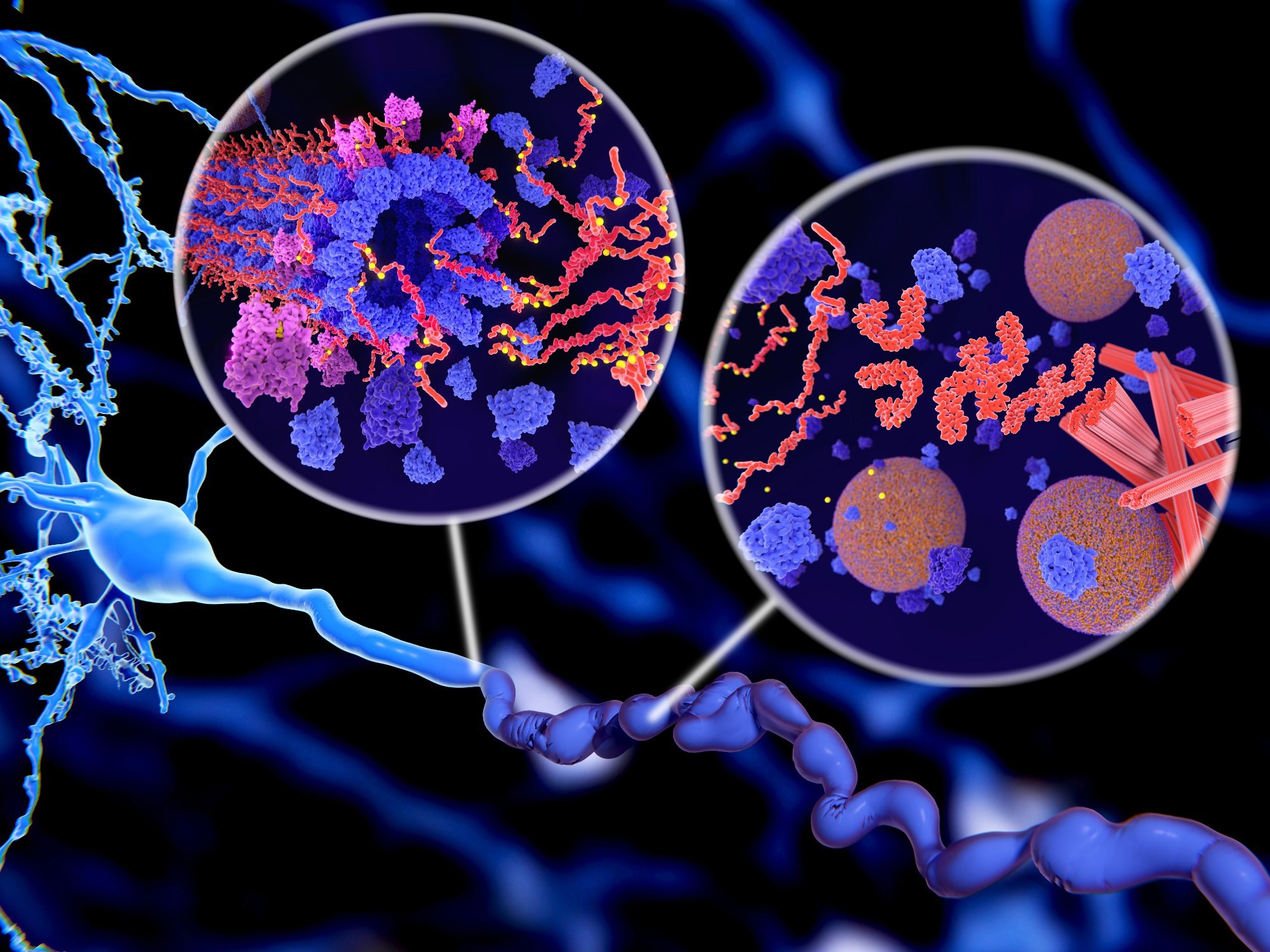The clumping together of misfolded proteins is known as protein aggregation. In several neurodegenerative diseases, including Alzheimer’s, Parkinson’s, and Huntington’s disease, proteins aggregate abnormally, causing disruption to normal cellular functioning and resulting in neuronal damage.1
Developing our understanding of the mechanisms that underlie protein aggregation is vital to furthering our knowledge of neurodegenerative diseases and establishing novel treatments and preventative strategies.
 Image Credit: Juan Gaertner/Shutterstock.com
Image Credit: Juan Gaertner/Shutterstock.com
Protein Aggregation: Foundations and Impact
Protein aggregation results from protein misfiling or the accumulation of proteins in abnormal configurations. It can be triggered by genetic mutations, post-translational modifications, and even environmental factors. Protein aggregations in neurodegenerative disorders can disrupt normal cellular functioning and contribute to disease pathology.
Research has identified certain proteins aggregated in several neurodegenerative diseases, including amyloid-beta, tau, alpha-synuclein, and Huntington.2
Often, these proteins accumulate within the neurons of cells and the surrounding tissue, leading to disease symptoms and progression. In many neurodegenerative diseases, it is believed these aggregates contribute to cognitive decline, psychiatric symptoms, and motor impairments.
Drug Discovery, Manufacturing, and Development
Mechanisms of Protein Aggregation in Neurodegeneration
Multiple biochemical and molecular mechanisms are responsible for protein aggregation in the brain. Genetic mutations, post-translational modifications, or an environmental factor often trigger protein misfiling.
As well as genetic mutations, there are also a number of genetic variants that are associated with an increased risk of neurodegenerative diseases (e.g., APOE gene variants have been linked with Alzheimer’s).
Next, the misfolded proteins self-assemble into oligomers and insoluble aggregates or fibrils. D dysfunction in protein clearance systems (e.g., autophagy) may further contribute to aggregation.3
In addition, chronic neuroinflammation can further exacerbate protein aggregation by releasing pro-inflammatory cytokines.
Finally, interactions with other components in the cell can result in further promoting aggregation.
Techniques for Studying Protein Aggregation
Numerous methods and technologies are commonly utilized for the study of protein aggregation.
Several advanced microscopy techniques are commonly used. Fluorescence microscopy, for example, allows for the visualization of protein aggregates within cells and tissues by adding fluorescent labels to antibodies or proteins. Confocal microscopy delivers high-resolution images of protein aggregates within cells, giving three-dimensional views.
Super-resolution microscopy techniques such as stochastic optical reconstruction microscopy (STORM) are also used to gain enhanced spatial resolution of images, facilitating detailed analysis of protein aggregates.
Spectroscopy techniques are also frequently employed in the study of protein aggregation. Fluorescence spectroscopy, for example, can provide information about protein conformational changes by measuring emission spectra associated with protein aggregation.
Fourier transform infrared spectroscopy (FTIR) is also used to identify conformational changes and aggregation-prone structures.4
A range of molecular biologic techniques are also utilized for this application, including protein fragmentation assays, cell culture models, protein expression and purification techniques, and site-directed mutagenesis.
Finally, biochemical assays such as thioflavin-T assay, size exclusion chromatography (SEC), and filter trap assay are also used to study protein aggregation.
While these methods are highly valuable in capturing the nature of protein aggregation, they also have some challenges and limitations.
Some microscopy techniques, for example, are limited by their resolution, making it difficult to distinguish different aggregation states with these techniques.
Fluorescent techniques are limited in that they can introduce artifacts that can impair the interpretation of the results.
Many molecular biologic techniques face the challenge of relying on in vitro assays that can not fully represent the dynamic environment in which protein aggregation occurs in real life. In addition, these methods are also limited in the structural information they can provide.
Finally, biochemical assays are often conducted in vitro and can not fully replicate the dynamic environments found in vivo. Additionally, biochemical assays tend to struggle to characterize the complexity of the structure of protein aggregates.
Therapeutic Implications of Understanding Protein Aggregation
There are a number of therapeutic strategies that target protein aggregation in neurodegenerative diseases. These strategies include small molecule inhibitors, monoclonal antibodies, and novel approaches like gene therapy.
Small molecules are used to prevent protein misfolding or disrupt pathways involved in aggregation. Monoclonal antibodies are being developed to target and clear aggregated proteins.5 Gene therapies are designed to deliver therapeutic genes that can improve existing protein clearance mechanisms or modulate the activity of proteins prone to aggregation.
Numerous ongoing clinical trials aim to evaluate the safety and efficacy of these various strategies in treating neurodegenerative diseases such as Alzheimer’s, Parkinson’s, and Huntingdon’s disease.
For example, several monoclonal antibodies are being studied for their potential therapeutic benefit in treating Alzheimer’s.5 In addition, gene therapy strategies are being explored in treating Parkinson’s disease.
Future Directions in Research on Protein Aggregation
The development of interdisciplinary approaches to understanding and treating protein aggregation in neurodegenerative diseases will likely be the central focus of future research. Such approaches will encompass biochemistry, genetics, pharmacology, and computational modeling.
There will be a growing emphasis on targeting multiple pathways and an increased focus on exploring innovative delivery methods of therapeutic interventions (e.g., nanoparticle delivery systems).
Conclusion
The need for continued research into the mechanisms of protein aggregation in neurodegenerative diseases is clear. Ongoing efforts in this area are vital for establishing novel treatments and preventative strategies for neurodegenerative diseases.
Resources and Further Reading
- Merlini, G. et al. (2001) ‘Protein aggregation’, Clinical Chemistry and Laboratory Medicine, 39(11). doi:10.1515/cclm.2001.172.
- Lee, S.-J. et al. (2011) ‘Protein aggregate spreading in neurodegenerative diseases: Problems and Perspectives’, Neuroscience Research, 70(4), pp. 339–348. doi:10.1016/j.neures.2011.05.008.
- Monaco, A. and Fraldi, A. (2020) ‘Protein aggregation and dysfunction of autophagy-lysosomal pathway: A vicious cycle in lysosomal storage diseases’, Frontiers in Molecular Neuroscience, 13. doi:10.3389/fnmol.2020.00037.
- Miller, L.M., Bourassa, M.W. and Smith, R.J. (2013) ‘FTIR spectroscopic imaging of protein aggregation in living cells’, Biochimica et Biophysica Acta (BBA) - Biomembranes, 1828(10), pp. 2339–2346. doi:10.1016/j.bbamem.2013.01.014.
- Cummings, J. (2023) ‘Anti-amyloid monoclonal antibodies are transformative treatments that redefine alzheimer’s disease therapeutics’, Drugs, 83(7), pp. 569–576. doi:10.1007/s40265-023-01858-9.
Last Updated: May 17, 2024